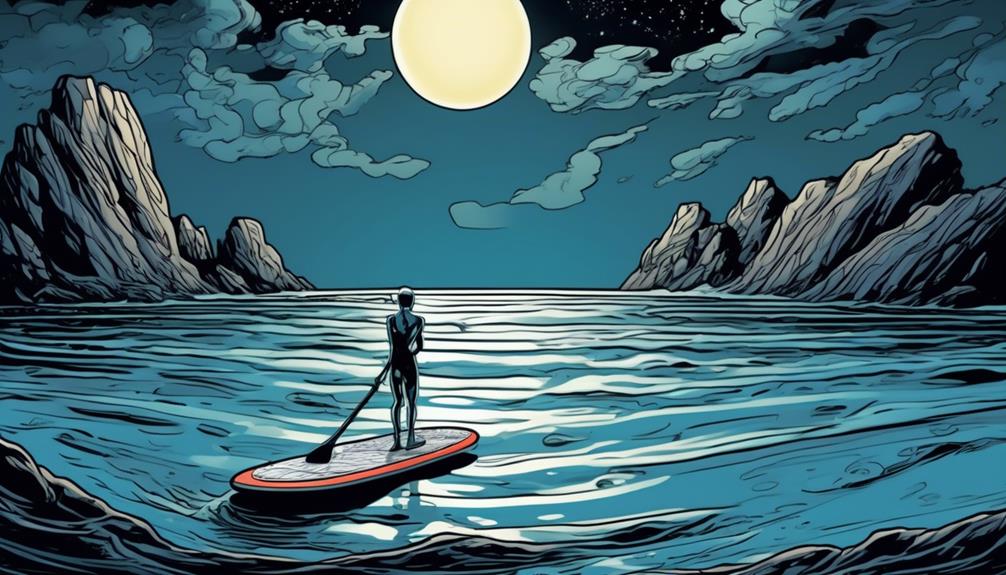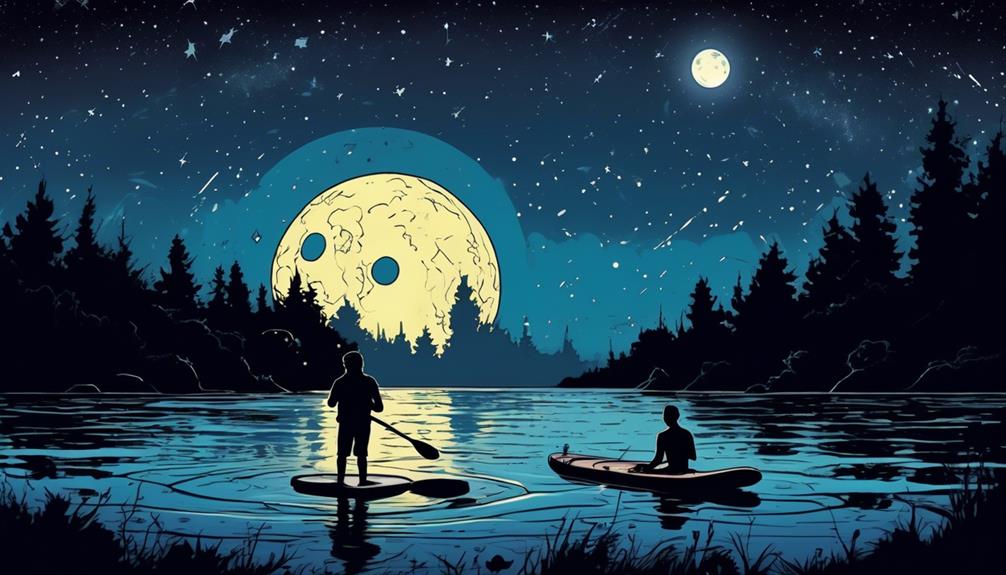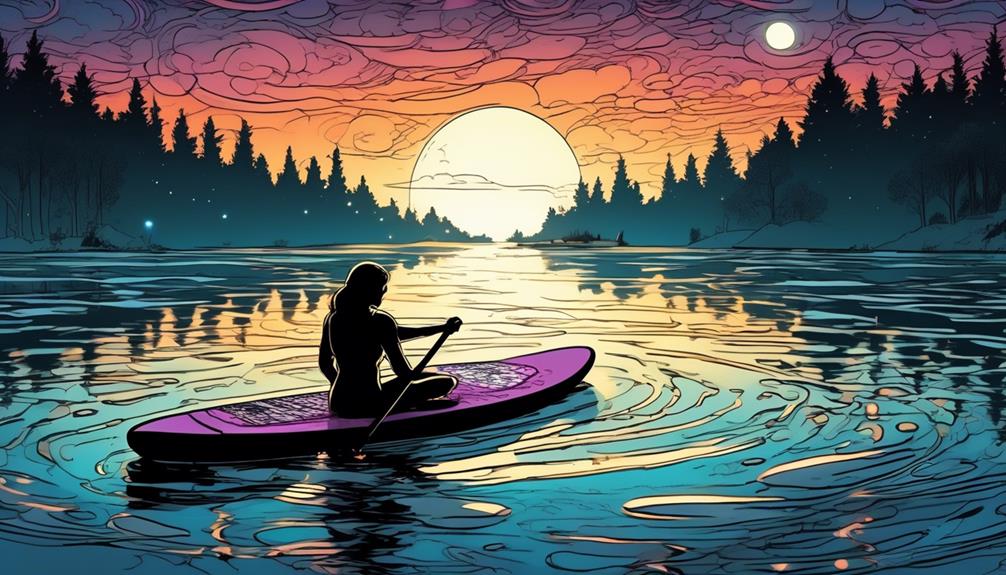Paddling under the stars might sound epic, but let's get real for a second. Hitting the water with your inflatable paddle board at night isn't just a casual jaunt; it's a whole different game.
From my own experiences and backed by solid data, night paddling amps up the risks. Visibility drops to nearly zero, not just for spotting obstacles but also for making sure others can see you. It's a fact: the risk of accidents skyrockets after dark.
You might think, 'But what about the adventure?' Sure, the thrill is there, but safety should always come first. According to safety reports, most paddle boarding mishaps happen because of two things: poor visibility and lack of proper gear. So, if you're really set on exploring after sunset, gearing up with the right safety equipment and knowing the legal requirements in your area is non-negotiable.
In short, can you paddle board safely at night? Yes, but only if you're well-prepared and informed. Stick around, and I'll show you how to ensure your nocturnal adventures are both safe and enjoyable.
Key Takeaways
- Nighttime paddleboarding carries certain risks, including poor visibility and decreased sense of direction.
- Using LED lights on the paddle board and wearing a high-visibility life jacket can significantly reduce these risks.
- Essential nighttime gear includes a waterproof headlamp, a Personal Flotation Device (PFD), and reflective tape on the paddle and board.
- It is important to be aware of and follow legal regulations regarding lighting requirements, life vest usage, and restrictions on nighttime paddling.
Understanding the Risks

Hitting the water with your inflatable paddle board at night might sound like an epic adventure, but let's talk facts and why it can quickly turn sketchy.
First up, the biggie: visibility. Imagine, it's pitch black, you're out there trying to have the time of your life, and boom, neither you nor anyone else can see a thing. Data shows that accidents on the water spike after dark, primarily because folks underestimate this. Without proper lighting, you're essentially invisible, and so are the obstacles floating around. Hitting a log at full paddle? Not my idea of fun.
Now, onto navigation. You think you know your local lake like the back of your hand, right? Wrong. Nighttime transforms it into an entirely different beast. Studies have demonstrated that people's sense of direction takes a nosedive in darkness. There's a real risk of getting turned around and not finding your way back until the sun comes up.
Then there's the drop in temperature. Both air and water get significantly colder after the sun goes down. This isn't just uncomfortable; it's dangerous. Falling into chilly waters can lead to hypothermia faster than you'd believe. And trust me, shivering in the dark waiting for rescue is far from enjoyable.
Let's not forget about the wildlife. Ever heard of nocturnal marine life getting a bit too close for comfort? Jellyfish, for instance, tend to surface at night. An unexpected sting can turn your nighttime paddle into a painful ordeal.
Given all this, you might wonder if it's even worth it to paddle at night. I get the thrill aspect, really, I do. But when you weigh that against the risks backed by data and real-world examples, it's a hard sell.
If you're dead set on it, consider alternatives that minimize these risks. Use LED lights on your board and wear a high-visibility life jacket. Plan your route during the day, stick close to the shore, and always paddle with a buddy. These steps can't eliminate all risks, but they significantly reduce them, making your night paddle safer and, honestly, more enjoyable.
Essential Nighttime Gear
So, you're thinking about hitting the water after sundown, huh? I've got to be honest, the idea of paddle boarding at night makes me a tad nervous. But, if you're set on it, let's talk about gearing up to not just survive, but thrive.
First things first, a waterproof headlamp is absolutely non-negotiable. You're not going to get far squinting into the dark or relying on your phone's flashlight. I learned this the hard way during a night paddle last year. Halfway through, my phone died, and let me tell you, paddling blind isn't fun. Look for a headlamp with at least 300 lumens; it's bright enough to light your path and make you visible to others. And those multiple brightness settings? They're gold for conserving battery or when you need to signal for help.
Now, onto the life jacket—or as the cool kids call it, a Personal Flotation Device (PFD). Here's the deal: 80% of drowning victims in boating accidents weren't wearing a life jacket. That's a staggering number, and it's not just the newbies. Seasoned swimmers overestimate their abilities, especially at night. Your PFD should feel like a second skin, so comfy that you forget it's there, but always on duty.
Lastly, let's jazz up your gear with some reflective tape. Before you roll your eyes, hear me out. Adding reflective tape to your paddle and board turns you into a glowing beacon in the night. It's not just about being seen; it's about being safely seen. A friend of mine decked out his gear this way, and the difference was night and day—literally. Cars on nearby roads could spot him, and so could other water enthusiasts.
So there you have it. Arm yourself with a top-notch headlamp, don't even think about skipping the PFD, and give your gear some reflective flair. It's about making smart choices based on real data and genuine experiences.
Stay visible, stay safe, and most importantly, enjoy the serene beauty of night paddle boarding with the confidence that you're prepared for anything.
Legal Considerations

Before you hit the night waters with your paddle board, let's talk legalities. Trust me, I'm all about seeking out those uncharted territories, but buckling down on regulations can save you a ton of headaches later. And let's be honest, tangling with the authorities is no one's idea of a good time.
First off, lighting requirements. You might think slapping a flashlight on your head and calling it a day is sufficient, but you'd be wrong more often than not. A study by the Coast Guard showed that most accidents at night involved poorly lit vessels. So, what's the deal? Well, many areas demand 360-degree lighting, ensuring you're visible from all angles. It's not just about seeing where you're going; it's about being seen.
Then there's the matter of life vests. Sure, you might be the Michael Phelps of paddle boarding, but the stats don't lie. According to the National Safety Council, wearing a life vest significantly reduces the risk of drowning, even for seasoned swimmers. And yes, many places legally require you to wear one. It's not about doubting your swimming prowess; it's about preparing for the unexpected.
Lastly, let's talk paddling zones. You'd think the open sea is fair game, but not so fast. Specific areas restrict night-time paddling to protect wildlife or ensure safety. For instance, certain conservation areas off the coast of Florida have specific time windows when you can paddle, primarily to protect nesting turtles. Ignoring these can't only harm the environment but can also lead to hefty fines.
Safety Tips and Practices
Alright, let's get straight to the point. Paddle boarding at night sounds epic, but without the right gear and knowledge, it's like playing roulette with your safety. I've been there, and after a few close calls, I'm here to share some data-driven advice that could save your skin.
First off, visibility is non-negotiable. We're talking about LED lights that make your board look like a UFO from afar. No joke, a study showed that adding visible lighting reduces the risk of accidents by up to 90% when engaging in nighttime water activities. So, ditch the idea of a weak flashlight. It's about going big or, well, getting lost at sea.
Now, let's chat about the personal flotation device (PFD). Not the peak of fashion, I get it, but hear me out. Data from the Coast Guard indicates that over 80% of drowning victims in water sports weren't wearing a PFD. It's a simple equation: wear a PFD, massively improve your survival odds.
And don't forget a whistle or any sound-making device. There's actual research showing that sound signals can be heard over 1,500 feet away in open waters. That's your lifeline if you're in trouble and need to be heard over the waves and wind.
Before you even think of hitting the water, check the weather and water conditions. Seems basic, but you'd be surprised how many folks don't. A sudden storm can turn your serene paddle into a life-threatening situation real quick. There's plenty of apps and websites offering real-time data on this, so no excuses.
Lastly, always inform someone about your plans. According to a safety report, having someone aware of your whereabouts increases your chances of a quick rescue by over 50% in case things go south. It's easy to overestimate your abilities in the dark, so this is a critical step.

